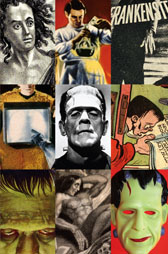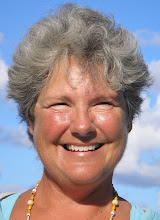We constantly discover references to the monster used as analogies for oddball biological creations. Hybrids and worse.
Here's this week's, from a syndicated Washington Post article about -- of all things -- an evergreen tree:
"The Leyland cypress (named after its 19th-century discoverer and champion, C. J. Leyland) might be likened to Frankenstein's monster. It is an unnatural creature, a weird cross between two entirely different evergreens, the Monterey cypress and the Alaskan cedar."
Fact is, cross-pollination and cross-grafting date back centuries. Our monster has botanical roots.
Sunday, April 29, 2007
Saturday, April 28, 2007
Goodbye and Hello
Today's news brings word of two distinguished biographers of Mary Shelley, mother of our favorite monster.
Emily Sunstein, an independent scholar recognized for her eloquent biographies on both Mary Wollstonecraft (mother of the mother of the monster) and Mary Shelley, died today in Philadelphia, according to an article in the New York Times.
And, in publishing news, Miranda Seymour (author of the most recent significant Mary Shelley biography) comes out with her own memoir, In My Father's House, characterized as a "subtle yet compelling" narrative by reviewer Mandy Sayer in the Sydney Morning Herald.
Emily Sunstein, an independent scholar recognized for her eloquent biographies on both Mary Wollstonecraft (mother of the mother of the monster) and Mary Shelley, died today in Philadelphia, according to an article in the New York Times.
And, in publishing news, Miranda Seymour (author of the most recent significant Mary Shelley biography) comes out with her own memoir, In My Father's House, characterized as a "subtle yet compelling" narrative by reviewer Mandy Sayer in the Sydney Morning Herald.
Friday, April 27, 2007
R.I.P. Mister Monster Mash
I've collected monster dolls and figurines for years. My favorite is a battery-operated dancing fellow with eyes that light up. He shakes his hips, churns his fists, and dances to the music. "He does the mash -- he does the Monster Mash." Now I read that Bobby Pickett, creator of the Monster Mash, has died at the untimely age of 65. Too much hanging out among the grey-skinned, I guess. He had his own website, still up and running even after its master has died.
Thursday, April 26, 2007
Maltese Frankenstein
The monster looms around the world. Today at http://noelother.blogspot.com/index.html actor Noel Tanti posted reminiscences and pictures of his portrayal of the monster on stage on the island of Malta. A Maltese monster. The monster lives in all of us, regardless of nationality or language. (Read the post to learn that this stage version of Shelley's story was written and performed in Maltese.)
Wednesday, April 25, 2007
Lighting Up Times Square
Tuesday, April 24, the lights turned on and the coming of the monster to Broadway took one more step toward reality. A larger-than-life billboard promising that "It's Alive!" lit up today, with no other writing on it other than "October 2007." Meanwhile, a Playbill writer suggested that the venue of Mel Brooks' promised Broadway version of "Young Frankenstein" may be the Hilton rather than the St. James (where "The Producers" just closed), giving the play a bigger stage and bigger audience. Here's a picture.
We await with bated breath.
We await with bated breath.
Tuesday, April 17, 2007
Let's Get Graphic
Catch a glimpse of the comic cover for the new Penguin FRANKENSTEIN, part of a series with standard texts of the classics inside but graphic artists' renditions of the classics for jacket art.
You can see our monster's version at http://pwbeat.publishersweekly.com/blog/.
One commenter says the creature looks like Crispin Glover, but I think he favors Christopher Lee. That eyeball, that eyeball...
You can see our monster's version at http://pwbeat.publishersweekly.com/blog/.
One commenter says the creature looks like Crispin Glover, but I think he favors Christopher Lee. That eyeball, that eyeball...
Monday, April 16, 2007
Broadway Here He Comes
News trickles out as the monster approaches Broadway.
When word of Mel Brooks's Broadway rendition of YOUNG FRANKENSTEIN first hit the Net, the claims were specific: opening for Halloween. Now the mentions are vaguer, although we do get an occasional hint at the cast -- like today's hunch that Sutton Foster is leaving The Drowsy Chaperone to be Inga. Megan Mullally, from Will & Grace, as Elizabeth; Brian D'Arcy James as Frahnkenshteen; and Shuler Hensley as the monster, according to recent Playbills online.
I noticed the last time I watched it that by the end of the film, the Gene Wilder character could care less how his name is pronounced. He has embraced his past and his monster -- and, besides, his endowments have grown tremendously.
When word of Mel Brooks's Broadway rendition of YOUNG FRANKENSTEIN first hit the Net, the claims were specific: opening for Halloween. Now the mentions are vaguer, although we do get an occasional hint at the cast -- like today's hunch that Sutton Foster is leaving The Drowsy Chaperone to be Inga. Megan Mullally, from Will & Grace, as Elizabeth; Brian D'Arcy James as Frahnkenshteen; and Shuler Hensley as the monster, according to recent Playbills online.
I noticed the last time I watched it that by the end of the film, the Gene Wilder character could care less how his name is pronounced. He has embraced his past and his monster -- and, besides, his endowments have grown tremendously.
Sunday, April 15, 2007
Midwife to Frankenstein
Talk about the proverbial flash in the pan. For a week or so, everyone -- even Germaine Greer -- was writing about John Lauritsen's new book, THE MAN WHO WROTE FRANKENSTEIN.
Come up with an outrageous idea and you get publicity. Lauritsen's idea: that Mary Shelley -- woman, teenager, unpublished author, a nobody in every way, he seems to suggest -- could not have written the masterpiece called FRANKENSTEIN.
His alternate suggestion: Percy Bysshe Shelley.
Come now. Read these two passages and tell me which sounds like the novel FRANKENSTEIN:
Passage 1. "No, no, I will not live among the wild scenes of nature, the enemy of all that lives. I will seek the towns -- Rome, the capital of the world, the crown of man's achievements. Among its storied streets, hallowed ruins, and stupendous remains of human exertion, I shall not, as here, find every thing forgetful of man..."
Passage 2. "So, as we rode, we talked; and the swift thought, winging itself with laughter, lingered not, but flew from brain to brain,--such glee was ours, charged with light memories of remembered hours, none slow enough for sadness; till we came homeward, which always makes the spirit tame."
Passage 1 is from another novel by Mary Shelley, THE LAST MAN, written after PBS died, so in no way attributable to her poet husband.
Passage 2 is a bit of Percy Bysshe's "Julian and Maddalo," a conversation poem, about the most prosaic he got in his published writing. I removed the line endings to make it read like narrative.
This is not an argument of quality -- whose is better -- but an argument of style. Percy Bysshe Shelley? As Mary herself wrote in the 1831 introduction to her novel, he was "more apt to embody ideas and sentiments in the radiance of brilliant imagery, and in the music of the most melodious verse that adorns our language, than to invent the machinery of a story."
The handwriting of both Percy Bysshe Shelley and Mary Wollstonecraft Godwin, who became Mary Shelley during the composition phase of her novel, is visible on the manuscripts and has been carefully studied by scholars.
He may have been midwife (midhusband??) to the novel, but it was Mary who gave the monster story birth.
-- Susan Tyler Hitchcock
Author of the forthcoming FRANKENSTEIN: A CULTURAL HISTORY to be published by W. W. Norton in October 2007
Come up with an outrageous idea and you get publicity. Lauritsen's idea: that Mary Shelley -- woman, teenager, unpublished author, a nobody in every way, he seems to suggest -- could not have written the masterpiece called FRANKENSTEIN.
His alternate suggestion: Percy Bysshe Shelley.
Come now. Read these two passages and tell me which sounds like the novel FRANKENSTEIN:
Passage 1. "No, no, I will not live among the wild scenes of nature, the enemy of all that lives. I will seek the towns -- Rome, the capital of the world, the crown of man's achievements. Among its storied streets, hallowed ruins, and stupendous remains of human exertion, I shall not, as here, find every thing forgetful of man..."
Passage 2. "So, as we rode, we talked; and the swift thought, winging itself with laughter, lingered not, but flew from brain to brain,--such glee was ours, charged with light memories of remembered hours, none slow enough for sadness; till we came homeward, which always makes the spirit tame."
Passage 1 is from another novel by Mary Shelley, THE LAST MAN, written after PBS died, so in no way attributable to her poet husband.
Passage 2 is a bit of Percy Bysshe's "Julian and Maddalo," a conversation poem, about the most prosaic he got in his published writing. I removed the line endings to make it read like narrative.
This is not an argument of quality -- whose is better -- but an argument of style. Percy Bysshe Shelley? As Mary herself wrote in the 1831 introduction to her novel, he was "more apt to embody ideas and sentiments in the radiance of brilliant imagery, and in the music of the most melodious verse that adorns our language, than to invent the machinery of a story."
The handwriting of both Percy Bysshe Shelley and Mary Wollstonecraft Godwin, who became Mary Shelley during the composition phase of her novel, is visible on the manuscripts and has been carefully studied by scholars.
He may have been midwife (midhusband??) to the novel, but it was Mary who gave the monster story birth.
-- Susan Tyler Hitchcock
Author of the forthcoming FRANKENSTEIN: A CULTURAL HISTORY to be published by W. W. Norton in October 2007
The Idea Behind Monster Sightings
For the last few years, as I have been working on my book FRANKENSTEIN: A CULTURAL HISTORY (coming from W. W. Norton in October 2007), I have been scanning the cultural horizon for sightings of the monster made by man.
Every day his visage looms. Every day someone refers to Frankenstein or his monster in the daily press. It's a twisted path of references, sometimes fascinating, sometimes silly, always interesting and worthy of note.
That's what I'll do here. Take note. And invite anyone else who comes upon the monster to share their visions and thoughts as well.
Every day his visage looms. Every day someone refers to Frankenstein or his monster in the daily press. It's a twisted path of references, sometimes fascinating, sometimes silly, always interesting and worthy of note.
That's what I'll do here. Take note. And invite anyone else who comes upon the monster to share their visions and thoughts as well.
Subscribe to:
Comments (Atom)




